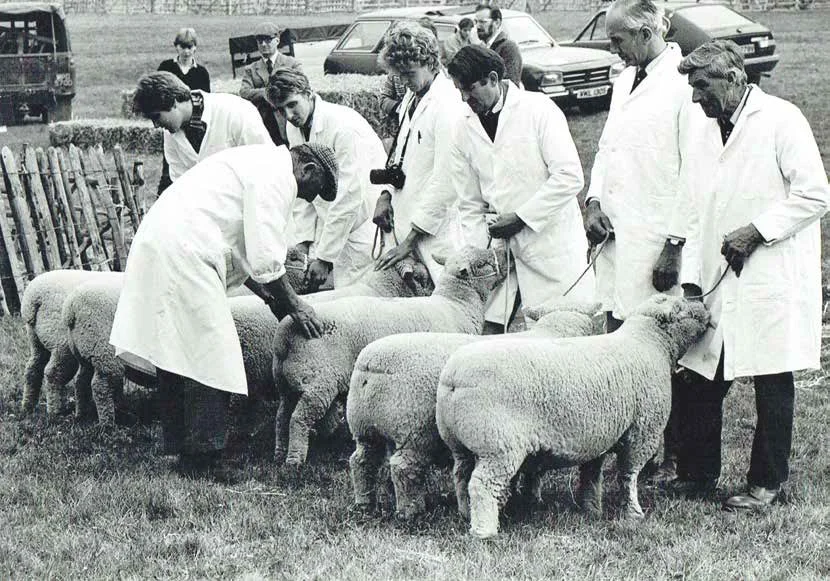Alexandra Long, Southdown Sheep Society President 2012-2013, at the National Southdown Show.
Alexandra Long treasures her earliest memories of bottle feeding lambs in the kitchen of the farmhouse she grew up in at Shoreham-by-Sea.
Her parents had a mixed farming enterprise, with the Chailey pedigree flock of Southdown sheep at its heart.
“I must have been five or six when I recall father coming in from the lambing sheds with lambs for me to feed,’’ she reminisces.
Now a grandmother, Alexandra is assuming a similar role in the sheep enterprise she has established with her own family. “It has gone full circle, when you are the youngest member of the family you do the bottle feeding and that is also the case when you are the oldest!’’ she laughs.
Her father died suddenly in 1991, but his influence in the sheep enterprise she shares with her son and daughter-in-law, Jonathan and Chrissie, and granddaughter, Sophie, lives on to this day because it includes the 35-ewe Chaileybrook flock, the culmination of 65 years of breeding by the family.
Frank Grantham
Continuity
Alexandra’s father was Frank Grantham, a respected Southdown breeder and long serving chairman of the Southdown Sheep Society. “When he died in 1991 we merged his Chailey flock with Jonathan’s recently formed Brook flock, giving continuity and maintaining the bloodlines my father had worked hard to develop,” she explains.
Frank had initially forged a career as a lecturer in agriculture, but his ambition was to farm. He achieved that goal after the Second World War ended. During the war he served with the 7th Armoured Division – the Desert Rats – and when he returned home he and his wife, Rhona, took on the tenancy of a small farm in Chailey, East Sussex.
They stocked it with 40 draft Southdown ewes purchased from the Ringmer and Ovingdean flocks.
“Father was a Sussex man and had always wanted to farm on the South Downs. The Southdown was the breed of that area, so it was natural fit for the farm,’’ says Alexandra.
The Southdowns provided sires for Frank’s commercial ewes, producing fat lambs to sell and for fatstock showing. “His love was the Southdown,’’ she adds.
In 1958, the Granthams expanded their business when they became tenants of a larger farm, at Shoreham-by-Sea.
Farming beckoned too for Alexandra when she married and moved to Kent where her husband had a large-scale sheep enterprise stocked with Suffolks and Romneys.
But, with a lifelong connection to the Southdown breed, Alexandra has always maintained an interest in the breed and has been an active Society member, serving as a Council member and a former president.
Frank Grantham judging at Findon Fair in the early 1980s
Historic imports
“It is quite incredible to look at the position the Society and the breed is in now, with nearly 300 active flocks, considering back in 1967 there were just 43 registered flocks.
“That the breed is in the position it is, is testament to the dedication of many breeders who stuck with the breed during the lean years and helped develop it with the use of different genetics from overseas,” explains Alexandra.
A lot of breeders have the misconception that imported stock have only played an influence in recent years, she says. “In fact, French rams were being used in the early and mid-1960s, with New Zealand rams arriving in the UK in 1967.
“These genetics spread quickly through the breed at that time due to the small number of flocks and the need to expand the genepool. With such a small number of flocks their influence would be everywhere.’’
Reflecting on the family’s own flock, Alexandra says a mix of genetics have played their part over the years, but the focus has always been on breeding a ‘correct’ Southdown, one that retains the characteristics of the breed, but delivers a viable commercial proposition by producing lean and long progeny. “It’s what the market wants,” she adds.
“We’ve been fortunate to develop the flock with a number of different bloodlines and continue to do so in an effort to progress the breed and grow the market for Southdown rams. Jonathan regularly visits French flocks and we’ve imported a number of rams from France over the last 15 years all of which have had an impact on the flock and continue to do so through their progeny.
Flock development
“We don’t import for the sake of it and Jonathan is very particular about the rams we buy whether in the UK or overseas and the costs involved in importing stock mean we have to be sure we’re buying something which will add to the flock’s development.”
A good bloodline always breeds superior progeny and at times that means importing genetics, she points out. “Everyone has their own views on what the Southdown should look like, we mustn’t forget the well recognised breed characteristics, but evolution of the breed is important too.’’
Capitalise on traits
Equally, when you look back at many of the photographs from the late 1800s and early 1900s it is clear the Southdown was a cleaner headed sheep than many you see now and had plenty of size and scope, believes Alexandra.
Looking ahead, she believes breeders must capitalise on the Southdown’s reputation as the perfect sire for a ewe lamb and for producing a good lamb carcass.
The shoulders of the Southdown are not as developed as many other breeds, so ease of lambing is there, she says.
“Additionally, the lamb doesn’t take too much out of the ewe lamb before it is weaned so it gives her time to grow further.
“What is really great about the breed though is the mix of people you find among the Society’s membership. It is a friendly Society and one I have always enjoyed being involved with.
“Like any breed Society the Southdown Sheep Society is a broad church and the breed has something for everyone, no matter what their reasons for owning sheep.”
Alex’s granddaughter Sophie is the fourth generation of the family to be involved with the breed, following the foundation of her own Littlebrook flock last year.






